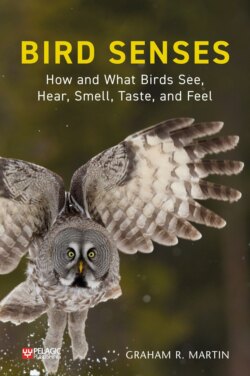Читать книгу Bird Senses - Graham R. Martin - Страница 35
На сайте Литреса книга снята с продажи.
Measuring other sensory dimensions
ОглавлениеIt is quite easy to imagine how the whole procedure described above can be adapted to investigate many other sensory questions. Instead of striped patterns, the stimulus panels could be uniformly lit with white light paired with an unlit panel, or with lights of different colours. Using these and adjusting light levels, it is possible to measure the minimum amount of light that can be reliably detected; that is, the absolute visual threshold can be determined. That too is a disconcerting task close to threshold.
Alternatively, it is possible to determine the threshold for detecting lights of different colours. In this way the sensitivity of the bird across the spectrum, its spectral sensitivity, can be determined. If lights of different colours are paired it is possible to determine how close they can be before they can no longer be told apart. This will give an indication of how fine the colour vision of the bird is. It is also possible to introduce flickering lights so that the slowest and fastest flicker speeds can be detected. This can have useful applications in that it gives a clue to how slow or fast a flickering light might need to be to act as a warning or distraction.
With other ingenuity and interests it can be seen how this kind of psychophysical approach can be used with sounds rather than light. In these kinds of studies birds are not trained to respond when they see something but when they hear it. Systematic alterations of sound levels and frequency can provide insights into a bird’s absolute sensitivity to sound, its relative sensitivity to sound of different frequencies (audiograms), and how finely the birds can discriminate between sounds of different frequencies. It would also be possible to introduce sounds with different time patterns, trills etc., and investigations with these can give insight into the ability of birds to detect differences in bird songs.
Some investigators have even been able to modify the overall procedure to work with smell and taste to determine which chemical stimuli are more salient and can be detected at low concentrations. However, controlling the smell or taste compounds and presenting them in a uniform way can be very difficult, and perhaps only a few trials can be done each session.
